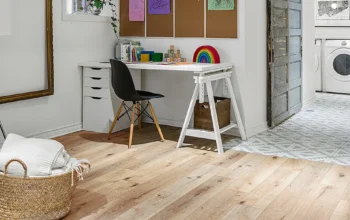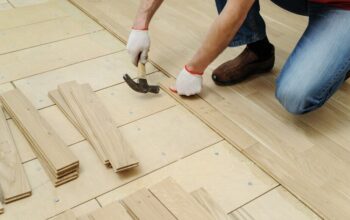Luxury Vinyl Plank (LVP) flooring has been a huge hit in recent times because it is affordable, long-lasting, and wood-like in appearance. Nevertheless, just like every other thing under the sun, LVP is not perfect either. If you are thinking of installing this kind of flooring in your home or business, you should know its possible negatives. In this article, we will look at the main drawbacks of luxury vinyl plank flooring to enable you to make an informed choice.
1. Less Environmentally Friendly
One of the largest issues with LVP flooring is its effect on the environment. Vinyl flooring is composed mainly of polyvinyl chloride (PVC), which is a petroleum-based product. The manufacturing process requires chemicals and energy-hungry production, creating a high carbon footprint. Most LVP products are also not biodegradable and can lead to landfill waste when they are thrown away.
Although a few manufacturers have begun making more environmentally friendly LVP products with recycled content, most products available today still carry environmental downsides. If sustainability is a major issue for you, you might consider other flooring options like engineered hardwood or bamboo.
2. Prone to Scratches and Dents
While LVP is also durable, it is not totally damage-proof. Heavy furniture, sharp objects, or pet claws can scratch and dent the surface. These blemishes may become apparent over time, especially in areas with heavy traffic.
In contrast to solid hardwood, which may be refinished several times, LVP can’t be sanded and refinished to erase scratches. If the wear layer is damaged, the only way out is replacing the scratched planks.
3. May Emit VOCs (Volatile Organic Compounds)
Some varieties of LVP flooring have volatile organic compounds (VOCs), which have the potential to off-gas into the atmosphere and impact indoor air quality adversely. VOCs are chemicals that evaporate when at room temperature and are normally present in synthetic materials, finishes, and adhesives.
Exposure to VOCs has been shown to produce symptoms including headache, dizziness, respiratory problems, and allergic reactions. Although some LVP products are identified as being low-VOC or FloorScore-certified, others can emit harmful emissions, particularly in unventilated areas.
4. Hard to Repair
Another huge drawback of LVP flooring is that it’s hard to fix when it becomes damaged. When compared to tile or hardwood, which can in many cases be refinished or replaced in parts, LVP planks need to usually be replaced entirely once they are damaged. When glued-down installation techniques were used on the flooring, removal can actually be even worse.
Also, reproducing the exact color and design of an older LVP installation can be difficult, since manufacturers often change designs. This results in even if you have extra planks, they might not match the remainder of your floor in the future.
5. Discoloration and Fading Potential
Long-term sun exposure may discolor or whiten LVP flooring. Direct sunlight contains UV rays that wear down the top layer over the years, which can lead to uneven color, a flat, washed-out finish, or cause it to dull.
Homeowners can avoid this by employing window treatments with UV-blocking capabilities, area rugs, or keeping the LVP off areas where too much sunlight pours in. That said, the restriction might prove to be aggravating, especially for individuals desiring maintenance-free flooring.
6. Can Feel Artificial Underfoot
Although LVP is engineered to look like genuine wood, it does not necessarily feel like hardwood underfoot. Some owners prefer that LVP does not have the warmth, texture, and authenticity of hardwood flooring.
Also, thinner LVP planks have a tendency to sound hollow or plasticky when stepped on, particularly if put down over an irregular subfloor. Underlayment can make the floor feel better, but it will increase costs.
7. May Be Susceptible to Water Damage at Seams
Though LVP is promoted to be waterproof, it is not completely resistant to water damage. Water does get through the seams between planks, particularly if they are not properly installed or maintained. This can result in mold and mildew development under the flooring, which can be challenging to treat.
Glue-down LVP installations are more moisture penetration resistant, but floating floors with click-lock systems can be prone to it if water has been standing on the surface for a long time. Proper installation and quick cleanup of spillage must be ensured to avoid moisture-related problems.
8. Limited Resale Value
Relative to actual hardwood or quality tile, LVP doesn’t bring much resale value to a property. Though it is affordable and fashionable, numerous buyers still want natural material when buying a property.
If you expect to sell your house in the future, investing in solid hardwood or engineered wood flooring can yield a higher return on investment. LVP remains an attractive choice for rental homes and cost-conscious homeowners, but it might not be attractive to buyers seeking high-end finishes.
9. Installation Challenges
Although LVP is usually marketed as simple to install, it may still be problematic for homeowners. Incorrect subfloor preparation can result in an uneven surface, making planks move or form gaps. Professional installation might be necessary in some instances to achieve a perfect finish, which increases the overall cost.
Additionally, some LVP products use glue-down installation, which can be labor-intensive and difficult to remove if repairs are needed. Even click-lock LVP can be tricky to install in irregularly shaped rooms or around obstacles.
10. Can Become Brittle Over Time
With time, certain LVP products can lose their flexibility and become brittle, particularly under extreme temperature conditions. Exposing the material to harsh heat or cold may expand and contract it, resulting in possible warping or cracking.
For homeowners who are contemplating LVP in unheated basements, sunrooms, or spaces with varying temperatures, it is essential to take note of this. Selecting high-grade LVP with a stable core and suitable climate control may minimize this problem.
Final Thoughts
Luxury Vinyl Plank flooring is very beneficial in that it is affordable, resistant to water, and has an abundance of design choices. Nevertheless, it does have its drawbacks. From its environmental impact to its limitations on durability and even health hazards, LVP may not be suitable for all homeowners.
Prior to a decision, balance the advantages and disadvantages thoroughly. Consider parameters like installation position, upkeep requirement, and long-term worth. If LVP meets your concerns and way of life, it can be an excellent flooring selection. If you consider natural materials, better resale value, and long-term longevity, other flooring options might be considered as well.
Have you used luxury vinyl plank flooring before? Let us know your experiences and opinions in the comments below!







I visited many blogs however the audio quality for audio songs present at this site is genuinely wonderful.
You ought to be a part of a contest for one of the highest
quality sites online. I most certainly will recommend
this web site!
Hi! I realize this is kind of off-topic but I needed to ask.
Does operating a well-established website such as yours take
a lot of work? I’m completely new to running a blog however
I do write in my diary daily. I’d like to start a blog so
I can share my experience and views online. Please let me
know if you have any ideas or tips for new aspiring blog owners.
Thankyou!
Hello there! This post could not be written any better!
Reading through this post reminds me of my good old room mate!
He always kept talking about this. I will forward this write-up to him.
Pretty sure he will have a good read. Many thanks for sharing!
My brother recommended I would possibly like this blog.
He was once entirely right. This publish truly made my day.
You cann’t imagine simply how so much time I
had spent for this info! Thank you!
Usually I do not learn post on blogs, but I wish to say that this write-up very compelled me to take a look at and do it!
Your writing style has been surprised me. Thanks, very
nice post.
Great article.
What a information of un-ambiguity and preserveness of precious know-how on the topic of unexpected
feelings.
Hey I know this is off topic but I was wondering if you knew of any widgets I could add to my blog
that automatically tweet my newest twitter updates. I’ve been looking for
a plug-in like this for quite some time and was hoping
maybe you would have some experience with something like this.
Please let me know if you run into anything. I truly enjoy reading your blog
and I look forward to your new updates.
My programmer is trying to convince me to move to .net from PHP.
I have always disliked the idea because of the expenses.
But he’s tryiong none the less. I’ve been using WordPress
on several websites for about a year and am worried
about switching to another platform. I have heard great things about blogengine.net.
Is there a way I can import all my wordpress content into it?
Any kind of help would be really appreciated!
Great post. I was checking constantly this blog and I’m impressed!
Very useful info specifically the last part 🙂 I
care for such information a lot. I was seeking this certain info
for a very long time. Thank you and best of luck.
Wow, this article is nice, my sister is analyzing such things,
so I am going to let know her.
Hi there, I found your blog via Google even as looking for a similar topic,
your website came up, it seems good. I have bookmarked it in my google bookmarks.
Hello there, simply changed into aware of your weblog via Google, and found that it’s truly informative.
I’m going to watch out for brussels. I will be grateful when you proceed this
in future. Many people will be benefited from your writing.
Cheers!
Please let me know if you’re looking for a article author for your site.
You have some really good posts and I think I would be a good asset.
If you ever want to take some of the load off,
I’d love to write some content for your blog in exchange for a link back to mine.
Please blast me an email if interested. Cheers!
Wow, superb weblog layout! How lengthy have you ever been running a
blog for? you made blogging look easy. The entire glance of your web site is excellent, let
alone the content!
It’s a shame you don’t have a donate button! I’d certainly donate to this brilliant blog!
I suppose for now i’ll settle for book-marking and adding your RSS feed to my Google account.
I look forward to new updates and will share
this site with my Facebook group. Talk soon!
Hmm is anyone else encountering problems with the pictures on this blog loading?
I’m trying to figure out if its a problem on my end or if it’s
the blog. Any feed-back would be greatly appreciated.
It’s genuinely very difficult in this busy life to listen news
on Television, therefore I simply use the web for that reason, and
obtain the newest information.
I’m really enjoying the theme/design of your site. Do you ever run into any web
browser compatibility issues? A handful of my blog audience have complained about my site
not working correctly in Explorer but looks great in Firefox.
Do you have any solutions to help fix this problem?
Ahaa, its nice discussion regarding this article here
at this weblog, I have read all that, so now me also commenting at this place.
Heya! I realize this is sort of off-topic however I had to ask.
Does managing a well-established blog like yours take a lot of
work? I’m completely new to operating a blog but I do
write in my diary on a daily basis. I’d like to start a blog
so I can easily share my experience and thoughts online. Please let me know if you have any suggestions or tips for brand new aspiring bloggers.
Thankyou!
Having read this I thought it was very enlightening. I
appreciate you spending some time and energy to put this article together.
I once again find myself spending a lot of time both reading and leaving comments.
But so what, it was still worth it!
I have been browsing online more than 3 hours today, but I never found
any interesting article like yours. It’s beautiful price enough for me.
In my view, if all site owners and bloggers made just right content material as you did,
the web might be a lot more helpful than ever before.
If some one desires expert view on the topic of blogging after that i suggest him/her to visit this website, Keep up the good job.
Howdy! I’m at work surfing around your blog from my new iphone 3gs!
Just wanted to say I love reading your blog and look
forward to all your posts! Carry on the outstanding work!
Thanks for a marvelous posting! I definitely enjoyed reading
it, you can be a great author. I will make sure to bookmark your blog and definitely will come back someday.
I want to encourage you to continue your great job, have a
nice weekend!
Very nice article, just what I was looking for.
I really like your blog.. very nice colors & theme. Did you make this website yourself or did you hire someone to do it for you?
Plz respond as I’m looking to construct my own blog and
would like to find out where u got this from.
many thanks
That is very fascinating, You are a very professional blogger.
I have joined your feed and stay up for in the hunt
for extra of your magnificent post. Additionally, I have shared your site in my social networks
At this time it appears like Movable Type is the best blogging platform available right now.
(from what I’ve read) Is that what you are using on your blog?
how can i send money to philippines
Hmm it appears like your site ate my first comment (it was extremely long) so I guess I’ll just sum it up what I wrote and say, I’m thoroughly
enjoying your blog. I as well am an aspiring blog writer but
I’m still new to everything. Do you have any tips for inexperienced blog writers?
I’d definitely appreciate it.